

Scale of climate change impact on infectious diseases analysed. The university’s Institute of Infection and Global Health said findings will help policymakers prioritise surveillance for pathogens that may respond to climate change and contribute to strengthening resilience for infectious diseases.
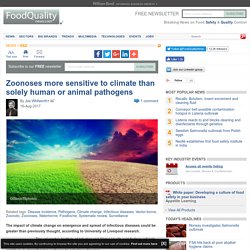
They assessed the scale of climate change impact on a range of diseases that significantly affect human and animal health. Climate-sensitive infectious diseases could change spatial distributions, annual/seasonal cycles or disease incidence and severity. Dr Marie McIntyre said usually the effects of changes in climate are examined for specific, selected pathogens or diseases. “Our work is different because we examined the climate sensitivity issue overall, in a more balanced way,” she told FoodQualityNews.
New food allergy resource website for young people. Teens and young people living with severe food allergies are being encouraged to start a conversation with their peers via a new website that could potentially save their lives.
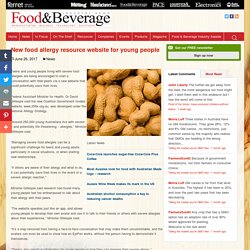
Federal Assistant Minister for Health, Dr David Gillespie said the new Coalition Government funded website, www.250k.org.au, was developed under the National Allergy Strategy. “Around 250,000 young Australians live with severe – and potentially life threatening – allergies,” Minister Gillespie said. “Managing severe food allergies can be a significant challenge for teens and young adults, particularly in social situations, or when starting new relationships.
“If others are aware of their allergy and what to do, it can potentially save their lives in the event of a severe allergic reaction.” Minister Gillespie said research had found many young people feel too embarrassed to talk about their allergy with their peers. “There’s also practical information for young people on how they can manage their severe allergy.” Severe food allergy claims increased 377% in the last decade. Dive Brief: The number of insurance claims filed for severe allergic reaction to food has increased 377% from 2007 to 2016, according to a study from FAIR Health.

Peanuts were the most commonly identified food causing a life-threatening allergic reaction. Tree nuts and seeds, eggs, crustaceans, milk products, fruits and vegetables, fish and food additives were also cited. “Other specific foods” containing an unknown allergen was listed as the cause for the most food allergy diagnoses.Roughly two-thirds (66%) of the claims were filed for patients 18 years old and younger, leaving about a third (34%) attributed to those over 18. RETEX sur l’évaluation en conditions réelles d’achat de 4 systèmes d’étiquetage nutritionnel simplifié.
Le FFAS a organisé le 4 juillet un retour d’expérience (RETEX) pour analyser les points forts et les points faibles du déroulement de l’expérimentation et tirer des recommandations pour la réalisation d’autres opérations de même nature.
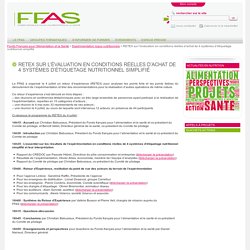
Ce retour d’expérience s’est déroulé en trois étapes : – des réunions et conférences téléphoniques avec un très large ensemble de personnes ayant participé à la réalisation de l’expérimentation, reparties en 10 catégories d’acteurs ; – une réunion le 4 mai avec 32 représentants de ces acteurs ; – une réunion le 4 juillet, au cours de laquelle sont intervenus 12 acteurs, en présence de 44 participants Ci-dessous le programme du RETEX du 4 juillet : INCA 3 : Evolution des habitudes et modes de consommation, de nouveaux enjeux en matière de sécurité sanitaire et de nutrition. L'actualité a été ajouté à votre bibliothèque Actualité du 12/07/2017 L’Anses publie ce jour les résultats de sa troisième étude sur les consommations et les habitudes alimentaires de la population française, INCA 3.
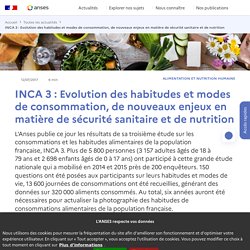
L'Anses publie les résultats d'INCA 3. En juin dernier, l'Anses a publié les résultats de la troisième Étude individuelle nationale des consommations alimentaires (INCA 3), qui vient actualiser les estimations de ces consommations et des apports nutritionnels.
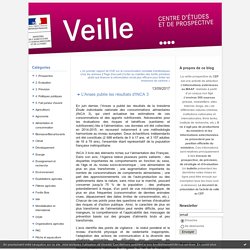
Interdiction de la malbouffe dans les écoles: efficace selon une étude canadienne. Saine alimentation à l'école Le 26 juin 2017 Une étude menée par un économiste de la santé de l’université du Nouveau-Brunswick indique que l’interdiction de la malbouffe dans les écoles a un effet positif sur l’indice de masse corporelle des jeunes.
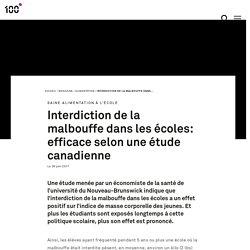
Et si les reçus de caisse affichaient les valeurs nutritives du panier d’épicerie? Étiquetage nutritionnel Le 12 juillet 2017 En Angleterre, où les valeurs nutritives des aliments sont déjà résumées par un code 3 couleurs, des spécialistes proposent maintenant de l’utiliser pour noter l’ensemble du panier d’épicerie sur le reçu de caisse.
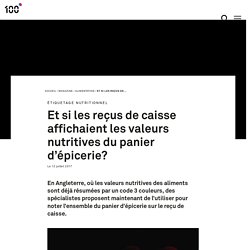
Depuis 2013, la grande majorité des emballages de produits alimentaires transformés affichent un code 3 couleurs, familièrement nommé Traffic Lights. "Avoir la peur au ventre" : une expression en fait proche de la réalité - France-Diplomatie - Ministère de l’Europe et des Affaires étrangères. Un rôle important dans la régulation de la peur Des chercheurs du centre APC Microbiome Institute, centre spécialisé dans la santé digestive basé à University College Cork et financé par l’agence Science Foundation Ireland (SFI), ont montré que les bactéries présentes dans le tube digestif (le microbiote intestinal) jouent un rôle important dans la régulation des réactions du corps face à la peur et modifient le fonctionnement du cerveau de la souris adulte.

Ainsi, chez les modèles animaux au moins, lorsque la communication entre le microbiome (environnement dans lequel vit le microbiote) et le cerveau est fortement perturbée, des mémoires associées à la peur sont ravivées et les voies moléculaires de l’amygdale, région clef du cerveau en charge de l’expression de l’anxiété et des comportements sociaux, sont modifiées. Farming and the geography of nutrient production for human use: a transdisciplinary analysis. Our analyses show that globally, farms smaller than 50 ha produce between 51% and 77% of the volume of the major food groups for human consumption: cereals, fruits, pulses, roots and tubers, and vegetables (figure 1figure 1).

Exceptions are sugar and oil crops, which tend to be produced on large farms (>50 ha) as large plantation crops, and livestock, of which 48% of global production is on small (≤20 ha) and medium (>20–50 ha) farms. Figure 1 Production of key food groups by farm size Although these global numbers are important, they mask substantial regional differences in what food is produced and how it is produced (figure 1figure 1 and figure 2figure 2). Large farms (>50 ha) dominate production in North America, South America, and Australia and New Zealand. Figure 2. In Bangladesh, people are eating more fish but getting less nutrition from it. People in Bangladesh are now eating 30% more fish than they did 20 years ago, but they are getting a smaller amount of important nutrients from it, a new study shows.
Fish is widely known as a healthy food, rich in protein and other nutrients, so how can this be? Well, it comes down to the types of fish available for people to eat. Une étude se penche sur la qualité nutritionnelle des régimes végétariens aux États-Unis. La revue Public Health Nutrition a publié récemment un article comparant la qualité nutritionnelle des régimes alimentaires avec ou sans viande. Les auteurs, appartenant à l'USDA, à un organisme de recherche gouvernemental et à des établissements d'enseignement en nutrition et en médecine, rappellent au préalable que les régimes à base de végétaux, bien menés, ont fait l'objet d'avis favorables de la part de certaines instances américaines (Académie de la nutrition et de la dietétique, dietary guidelines for americans). Diet quality on meatless days: National Health and Nutrition Examination Survey (NHANES), 2007-2012.
Agir sur les comportements nutritionnels, une expertise collective de l’Inserm. © Fotolia Pour faire face à cette hausse de l’obésité en France, l’État a mis en place dès 2001, une politique publique de santé nutritionnelle en lançant le Programme National Nutrition Santé (PNNS).En 2007, un décret de la loi de santé publique de 2004 impose que les publicités en faveur des produits alimentaires manufacturés et des boissons avec ajouts de sucres, sel, édulcorants de synthèse, doivent contenir une information à caractère sanitaire. Cette disposition s’applique quels que soient les médias (télévision, radio ou affichage publicitaire). Le Stévia apporte de nouvelles perspectives de lutte contre le diabète - France-Diplomatie - Ministère de l’Europe et des Affaires étrangères. Deux chercheurs de la KU Leuven, Koenraad Philippaert et Rudi Vennekens, ont montré que des composants actifs du stévia renforcent l’action du canal de cations TRPM5, permettant au pancréas de libérer suffisamment d’insuline pour prévenir une élévation anormale de la glycémie.
Undeclared allergens a leading cause of food recalls in U.S. Food recalls related to illness outbreaks tend to get a lot of headlines, but undeclared allergens in foods continue to be a leading cause of recalls. To read a report from the University of Nebraska-LincolnFood Allergy Research and Resource Program about the number of FDA and USDA recalls related to undeclared allergens, please click on the image. In the past 60 days, there have been 44 food recalls posted by the Food and Drug Administration, with 19 of them for undeclared allergens. That would have by far accounted for the majority of food recalls, had it not been for 10 cheese recalls that involved one manufacturer. One in three adolescents is obese, say WHO.
Childhood obesity is now considered one of the most serious public health challenges of the 21st century. The report, which shows data from 27 countries and regions across Europe between 2002 and 2014, was presented at the European Congress on Obesity in Portugal. Younger adolescents, boys and those living with families in a lower socioeconomic position are most likely to be obese and thus carry an increased risk of type 2 diabetes, asthma, sleep difficulties, musculoskeletal problems and cardiovascular disease in the future. Australian obesity increases despite lower sugar intake. A new study has found that despite consumers’ decreased sugar intake, Australian obesity rates are higher than ever. In recent years, scientists have linked excessive sugar consumption with obesity. Is a diet low in greenhouse gas emissions a nutritious diet? – Analyses of self-selected diets in the LifeGene study. This research used the self-reported diet information from a Swedish population-based pilot study, for a project called ‘LifeGene’, in which a total of 5,364 participants completed an interactive FFQ (that assessed habitual dietary intake of the previous month, as well as meal patterns and eating behaviour), and visited a clinic to have measurements taken.
LifeGene is a prospective Swedish cohort study, projected to last 20 years, that seeks to combines modern biotechnology with information on individual’s health and lifestyle. Obesity now ranked as a chronic disease by the World Obesity Foundation in hope it will help encourage policy action. Consommation de viande rouge et risque de cancer de l’estomac : revue scientifique et méta-analyse - CIV - Viande, Sciences et Société. Contexte : Les études des associations observées entre les consommations de viande rouge fraiche et celle de viande transformée (charcuterie) avec le risque de cancer de l’estomac sont restées peu concluantes. C’est pourquoi des chercheurs chinois ont effectué une analyse systématique de la littérature sur le sujet ainsi qu’une méta-analyse. Méthodologie: Ils ont cherché sur PubMed et EMBASE à identifier les études publiées sur le sujet jusqu’en octobre 2016.
Les analyses sur les sous-types du cancer gastrique (cardia adénocarcinome gastrique et adénocarcinome gastrique non cardiaque) ainsi que les analyses dose-réponse ont été recherchées : 42 études éligibles ont ainsi été identifiées. Associations between motives for dish choice during home-meal preparation and diet quality in French adults: findings from the NutriNet-Santé study. Eating dependence and weight gain; no human evidence for a ‘sugar-addiction’ model of overweight - ScienceDirect. <div pearltreesdevid="PTD138" role="alert" class="alert-message-container"><div pearltreesdevid="PTD139" aria-hidden="true" class="alert-message-body"><span pearltreesdevid="PTD140" style="display: inline-block;" class="Icon IconAlert"><svg pearltreesDevId="PTD141" style="width: 100%; height: 100%;" width="24" height="24" focusable="false" tabindex="-1" fill="currentColor"><path pearltreesDevId="PTD142" fill="#f80" d="M11.84 4.63c-.77.05-1.42.6-1.74 1.27-1.95 3.38-3.9 6.75-5.85 10.13-.48.83-.24 1.99.53 2.56.7.6 1.66.36 2.5.41 3.63 0 7.27.01 10.9-.01 1.13-.07 2.04-1.28 1.76-2.39-.1-.58-.56-1.02-.81-1.55-1.85-3.21-3.69-6.43-5.55-9.64-.42-.52-1.06-.83-1.74-.79z"></path><path pearltreesDevId="PTD143" d="M11 8h2v5h-2zM11 14h2v2h-2z"></path></svg></span><!
-- react-text: 58 -->JavaScript is disabled on your browser. Please enable JavaScript to use all the features on this page. <! -- /react-text --></div></div> Abstract. Cross-national investigation of the drivers of obesity: Re-assessment of past findings and avenues for the future - ScienceDirect. <div pearltreesdevid="PTD138" role="alert" class="alert-message-container"><div pearltreesdevid="PTD139" aria-hidden="true" class="alert-message-body"><span pearltreesdevid="PTD140" style="display: inline-block;" class="Icon IconAlert"><svg pearltreesDevId="PTD141" style="width: 100%; height: 100%;" width="24" height="24" focusable="false" tabindex="-1" fill="currentColor"><path pearltreesDevId="PTD142" fill="#f80" d="M11.84 4.63c-.77.05-1.42.6-1.74 1.27-1.95 3.38-3.9 6.75-5.85 10.13-.48.83-.24 1.99.53 2.56.7.6 1.66.36 2.5.41 3.63 0 7.27.01 10.9-.01 1.13-.07 2.04-1.28 1.76-2.39-.1-.58-.56-1.02-.81-1.55-1.85-3.21-3.69-6.43-5.55-9.64-.42-.52-1.06-.83-1.74-.79z"></path><path pearltreesDevId="PTD143" d="M11 8h2v5h-2zM11 14h2v2h-2z"></path></svg></span><!
-- react-text: 58 -->JavaScript is disabled on your browser. Please enable JavaScript to use all the features on this page. <! Un outil de calcul des coûts du diabète sur 10 ans au Canada. D’ici 2022, on estime que 2,16 millions de nouveaux cas de diabète seront diagnostiqués, entraînant des coûts qui atteindraient 15,36 G$, révèle une étude. Unhealthy diets linked to more than 400,000 cardiovascular deaths. Eating a diet lacking in healthy foods and/or high in unhealthy foods was linked to more than 400,000 deaths from heart and blood vessel diseases in 2015, according to an analysis presented at the American Heart Association's Epidemiology and Prevention / Lifestyle and Cardiometabolic Health 2017 Scientific Sessions. Eating more heart healthy foods, and less foods with high amounts of salt and trans fats, could save tens of thousands of lives in the United States each year, researchers said.
Low gluten diets linked to higher risk of type 2 diabetes. Eating more gluten may be associated with a lower risk of developing Type 2 diabetes, according to research presented at the American Heart Association's Epidemiology and Prevention / Lifestyle and Cardiometabolic Health 2017 Scientific Sessions.
Gluten, a protein found in wheat, rye and barley, gives bread and other baked goods elasticity during the baking process and a chewy texture in finished products. A small percentage of the population cannot tolerate gluten due to Celiac disease or gluten sensitivity, but gluten-free diets have become popular for people without these conditions, even though there is lack of evidence that reducing gluten consumption provides long-term health benefits.
Traffic-light labels could reduce population intakes of calories, total fat, saturated fat, and sodium. Abstract Traffic-light labelling has been proposed as a public health intervention to improve the dietary intakes of consumers. OBJECTIVES: to model the potential impact of avoiding foods with red traffic lights on the label on the energy, total fat, saturated fat, sodium, and sugars intakes of Canadian adults. METHODS: Canadian adults aged 19 and older (n = 19,915) who responded to the Canadian Community Health Survey (CCHS), Cycle 2.2. The nutrient levels in foods consumed by Canadians in CCHS were profiled using the United Kingdom’s criteria for traffic light labelling. Whenever possible, foods assigned a red traffic light for one or more of the profiled nutrients were replaced with a similar food currently sold in Canada, with nutrient levels not assigned any red traffic lights.
Citation: Emrich TE, Qi Y, Lou WY, L’Abbe MR (2017) Traffic-light labels could reduce population intakes of calories, total fat, saturated fat, and sodium. A digital PCR method for identifying and quantifying adulteration of meat species in raw and processed food. Prospective association between consumption frequency of organic food and body weight change, risk of overweight or obesity: results from the Nutri... The rise and the recent decline of childhood obesity in Swedish boys: the BEST cohort. Fast-food packaging contains potentially harmful chemicals that can leach into food. L’obésité touche quatre fois plus les enfants d’ouvriers que ceux de cadres. Fruit and vegetable intake and the risk of cardiovascular disease, total cancer and all-cause mortality—a systematic review and dose-response meta-analysis of prospective studies. Obésité et diabète de type 2. Sucres libres. Children’s drink choices influenced by personalized labels, study.
Prenatal BPA exposure may lead to weight issues later in life: Mice study. ‘Strong evidence’ supports obesity and cancer link: British Medical Journal. Tackling childhood obesity - Think Tank. Sugar, salt, and fat taxes could save billions in health care costs. Can probiotics modulate human disease by impacting intestinal barrier function? Campagne de sensibilisation en Angleterre : une application mobile scrute plus de 114 000 produits alimentaires. Pour vivre vieux, mangez des noix. Hacking epidemics in a hyper-connected world. Aux Etats-Unis, une nouvelle étude revoit à la hausse le rôle du diabète dans les décès. Microbiote et fibres alimentaires. Les rayons UV comme alternative aux antibiotiques.
Microbiote intestinal : aperçu de quelques axes de recherche au Japon. Food Politics by Marion Nestle » The pros and cons of taxing foods based on their sugar content. EU health coalition calls for 6am-11pm ban on junk food advertising. Cerin – Cholé-doc : « Nutrigénétique et maladies métaboliques » FAO - News Article: Overweight affects almost half the population of all countries in Latin America and the Caribbean except for Haiti. OpenFoodTox: EFSA’s new one-click tool for information on chemical hazards. Consumption of fruits and vegetables among adolescents: a multi-national comparison of eleven countries in the Eastern Mediterranean Region. Fatty acid dietary intake in the general French population: are the French Agency for Food, Environmental and Occupational Health & Safety (ANSES) national recommendations met?
Can probiotics modulate human disease by impacting intestinal barrier function? Consumption of ultra-processed foods predicts diet quality in Canada. Consumption of ultra-processed foods predicts diet quality in Canada. Behavioural measures of child's eating temperament and their link with BMI. Mise à jour de la base de données CIQUAL sur la qualité nutritionnelle des aliments. Mise à jour majeure de la table Ciqual, outil de référence sur la composition nutritionnelle des aliments.
L’Anses actualise les repères de consommations alimentaires pour la population française. Nanoparticules de dioxyde de titane : une présence alimentaire préoccupante pour la santé. Les mauvaises habitudes de vie seraient responsables de la moitié des décès au Canada. Le phénomène « pro-ana ». Par-delà le mythe de l’apologie de la maigreur sur Internet. Quand le microbiote fait de la résistance à l’insuline.
Innovations Agronomiques. Colloque Allergies, intolérances et hypersensibilités alimentaires. Volume 52 / Septembre 2016. Une possible prévention nutritionnelle pour limiter le risque de cancers liés au fer des produits carnés. La malnutrition chez les personnes âgées. Brain response to fat could determine future path in tackling obesity, study says. Poor regulation of powerful digital ads undermines childhood obesity work: WHO. Reducing meat consumption in developed and transition countries to counter climate change and biodiversity loss: a review of influence factors.
Métagénomique : quelles avancées pour l’évaluation de l’exposition microbiologique domestique ? - CIV - Viande, Sciences et Société. Nutrition, impact carbone et alimentation des animaux : les résultats du projet de recherche Agralid - CIV - Viande, Sciences et Société. Le Bulletin épidémiologique hebdomadaire publie les premiers articles à partir de la cohorte Constances. Constances : une cohorte française pour la recherche et la santé publique. RelAte: pilot study of the effects of a mealtime intervention on social cognitive factors and energy intake among older adults living alone. L'Anses publie les résultats de l’Étude Alimentation Totale infantile. L’Anses passe au crible l’alimentation des enfants de moins de trois ans. Body-mass index and all-cause mortality: individual-participant-data meta-analysis of 239 prospective studies in four continents.
Des smartphones pour mesurer, analyser et guider les consommations alimentaires. Des fruits locaux gratuits contre le diabète à Los Angeles ! Breaking the Cycle of Obesity - 2016 - News Releases - News. Enquête britannique sur les personnes allergiques et leur alimentation hors domicile. Belgium to reduce nation's calorie intake by 5% Facebook could be making kids fat: report. Taking a bite out of calorie-counting: New app helps users lose weight. Protein expression drives metabolic changes to increase obesity risk. WHO adds more cancer types linked to excess weight. Food Literacy: Key concepts for health and education.
How under-reporting of consumption can explain the apparent fall in UK calorie intake. Researchers develop new variety of soybean lacking the proteins that cause allergic reactions. Global obesity target not reached if trend continues. La mode du régime sans gluten passée au crible de l’appareil scientifique. Un défaut génétique pourrait être à l’origine du diabète de type I et de type II. EU Hackathon: EFSA offers €20,000 for app ideas. FINAL CONFERENCE - NU-AGE. Investor group launches campaign to curb antibiotic use in food. L'obésité touchera 20 % de la population mondiale dans 10 ans.